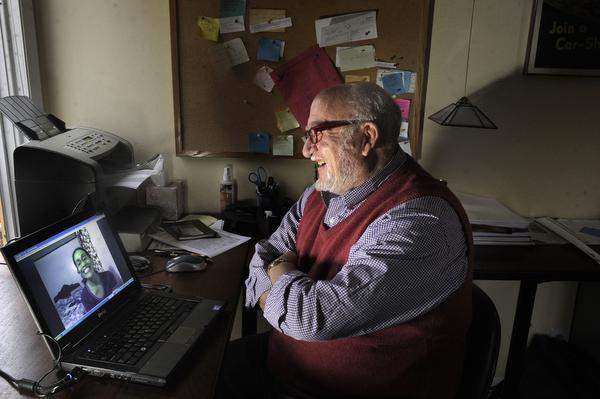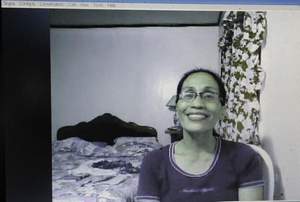
Vanderbilt professor, Filipina fiancee say convoluted U.S. i
tennessean.com | 2014-01-23 15:04

Vanderbilt professor Stephen Heyneman and Mayme Ticobay, who lives in the Philippines, talk daily using videoconferencing.

Mayme Ticobay hopes to come to the U.S. to be with her fiance. But a visa has been hard to come by. In the Philippines alone, where Ticobay lives, 436,639 people are waiting for immigrant visas, second only to Mexico. / John Partipilo / The Tennessean
This might be an improbable love story, but it’s instructive nonetheless.
Stephen Heyneman, a 70-year-old Vanderbilt professor, long divorced and his children grown, decided about four years ago that it was time to look for a companion. So he posted a profile to an online dating site.
The results were predictable, by and large. Women, mostly around his age, from Kentucky and Tennessee. But there was one person who caught his eye ----a woman in her mid-50s living in a small fishing village on the Philippine island of Palawan. Years ago, when Heyneman worked for the World Bank, he had traveled to the same village with a daughter.
Heyneman says he opened a conversation. That conversation bloomed into a friendship, which soon blossomed into something more. Soon Heyneman was meeting her family in the Philippines, in June 2011.
The visit went well, so Heyneman decided to pursue the next logical step. He invited her to come see him in Tennessee.
That is when the trouble began. And it was trouble that would bring them face to face with the formidable obstacles inherent in America’s legal immigration system.
More than two years later, Heyneman and Mayme Ticobay, a former nurse who now makes her living offering loans to small farmers, say they are closer than ever. Thanks to cheap videoconferencing over the Internet, Heyneman begins each of his days ---- and Ticobay ends each of hers----face to face, discussing everything from their daily routines to their religious faiths.
They have decided to get married, but that has proved more difficult than either of them imagined.
Heyneman says he’s begun to lose hope that Ticobay will ever join him in his home next to Old Hickory Lake. Immigration officials have denied their requests for visas three times, and they see little recourse.
Heyneman and Ticobay’s story of modern romance thwarted by bureaucracy may seem unusual---- unlikely, even. Their saga nonetheless demonstrates the difficulties that hundreds of thousands of would-be immigrants face when they attempt to move to the United States legally, through proper channels. It also shows the lengths many people will go to try to clear those hurdles.
Despite in-demand nursing skills, relatives in the country and an American citizen who says he intends to marry her when she arrives, Ticobay appears to face a wait of as long as two decades to obtain a visa, thanks largely to high demand in her home country.
Many advocates hope immigration reform, which has made its way onto the agenda once again in Washington, will relieve the backlog. But Heyneman and Ticobay say they can do little more than hope that somehow the situation changes.
Three denials
The plan at first was to take things slowly. Ticobay would travel to the U.S. on a tourist visa. She would meet Heyneman’s family and see where he lived. Then they would take things from there.
But it would not work out that simply. Their application for a tourist visa was denied. Officials said they were afraid Heyneman and Ticobay would elope once she arrived, according to the couple and Linda Rose, the Nashville attorney they retained to help them with their immigration filings.
In June 2012, they instead tried to obtain a fiancee visa for Ticobay. The application took nearly a year to complete, during which time Ticobay gathered hundreds of pages of computer logs, correspondence and photographs from Heyneman’s three trips to the Philippines. One photo, which Heyneman keeps in his study at home, shows him at Ticobay’s home in Narra, posed alongside her aging father and several siblings. (Ticobay’s only child is a permanent resident of Great Britain, where he works as a hospital nurse.)
With those documents in hand, Ticobay made the short flight to Manila, the Philippine capital, for an interview at the U.S. Department of State’s embassy. She arrived for her appointment at 7 a.m. with about 300 other potential emigrees and waited for her turn in a room that sounds, to an American listener, like it was inspired by a trip to the DMV.
After several hours, Ticobay was called to a small window where she was asked a few questions: How had she and Heyneman met? What were their plans?
No official asked to view Ticobay’s documentation. Around midafternoon, she was called to another window. There she was told her application had been denied.
Ticobay would repeat the process a few months later, when she applied again. Same result.
Ticobay was given no explanation, but she said in an interview over the Internet that she understands why embassy officials might be wary. Meeting online was surely a red flag, and neither she nor Heyneman could offer an explanation for how their profiles were matched.
Ticobay also admits that she stretched the truth when she initially filed for a fiancee visa. She claimed on her application that she was widowed when her estranged husband had not yet died. But he would pass away before her application was reviewed, she added.
Perhaps most damaging to her cause, however, were the other Filipina women she met at the embassy. Several told her they had no real affection for the men they had agreed to marry. One confessed she did not plan to go through with the marriage once she arrived.
“It’s very embarrassing to me as a Filipina”, she said. “It’s just not right, going to the United States, just using someone only for your sake.
“But I asked myself, does, really, the U.S. embassy know?”
Long waits
There are schemers who go to great lengths to come into the United States, and there are those who are honest who go to equally great lengths. Distinguishing their stories can be difficult, as Ticobay concedes, but to those who are skeptical about their relationship---- at the embassy and elsewhere ---- Heyneman says this:
“I’m not looking for a 20-year-old. I’m not looking for some arm candy. ... It can be very romantic to have a real partner, and with Mayme, we’ve been really, really happy together.”
The State Department cannot comment on individual visa applications, a spokesman said, making it difficult to corroborate their story. But ultimately, everyone who hears their tale must ask themselves a question that confronts U.S. embassy officials day in and day out:
How can you prove whether two people are really in love?
It may not be possible, yet that determination is important under U.S. immigration law, especially as the line to get into the country grows longer.
As of Nov. 1, about 4.3 million people worldwide had immigrant visa applications pending in embassies worldwide. But only 376,000 will have their applications approved in 2014.
From the Philippines alone, 436,639 people are waiting for immigrant visas, second only to Mexico.
Fiancees of American citizens do not have to wait in that line. But to obtain such a visa, they must show they are free to marry, have seen each other within the past two years and plan to marry within 90 days of arrival. They also must present evidence of their relationship----a vague requirement that Heyneman and Ticobay hoped to satisfy with photos, computer records and other documents showing their courtship over the past three years.
Worldwide, about 25,000 to 30,000 are granted each year, according to State Department data.
The penalties for lying can be severe. Coming to the U.S. on a tourist visa and then marrying carries a possible fine of $10,000 and up to five years in prison. Staying in the country without marrying on a fiancee visa can mean deportation and difficulties immigrating in the future.
But Ticobay’s other options are limited. She does have a brother and a sister living in the United States who could sponsor her, but such sibling visas are difficult to obtain. More than 170,000 Filipinos have applied for sibling visas, according to the State Department, and the line stretches back to applications filed in February 1990.
With her training as a nurse, Ticobay also could apply for a work visa. But she is approaching retirement age, hasn’t worked as a nurse since her son was born a quarter century ago and doubts she could pass the mandatory licensing exam. Besides, only about 2,000 to 3,000 Filipinos are granted work visas a year, according to the State Department.
For his part, Heyneman says he’s ruled out moving to the Philippines.
“I have six grandchildren, and I love them all, and I’m not fleeing from anything,” he said. “I see no reason why Mayme can’t live here with me.”
That leaves the illegal route. Neither is willing to try it, but Heyneman concedes that, after years of working through legal channels, he has considered the possibility fleetingly.
“It has crossed my mind ---- get Mayme to Canada and put her in a truck----crazy things,” he said.”They’re making this one choice, letting other women in and not allowing her.”
It may seem implausible that two people would find each other on the other side of the world, but Heyneman and Ticobay say their love is simple. The complicated piece, they argue, is an immigration system that has kept them apart.
Share this page



















